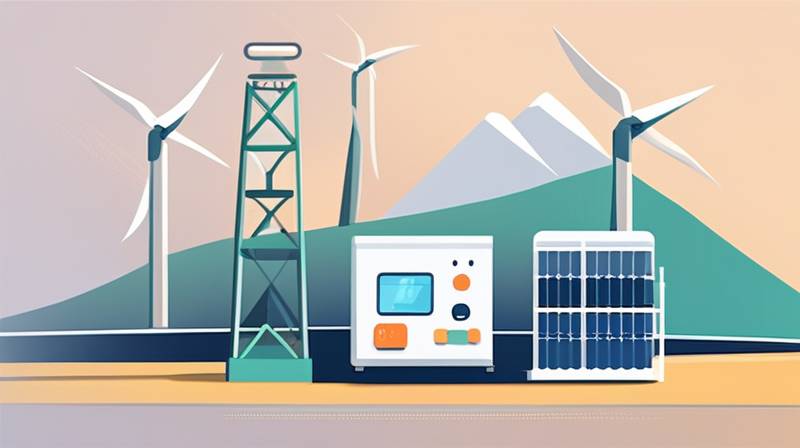
How much does wind power storage cost? The expenses related to wind energy storage hinge on an array of factors, including 1. Technology employed, 2. Scale of the storage system, 3. Location and infrastructure, 4. Duration of storage required. The particular technology, such as battery storage versus pumped hydro, distinctly influences installation, maintenance costs, and lifespan. For instance, while lithium-ion batteries have gained traction due to their scalability and efficiency, they can be expensive compared to more traditional methods. Additionally, the specifics of the locality, such as land use and available infrastructure, could lead to variations in the overall investment required. A thorough understanding of these elements enables developers to evaluate the most financial and operationally viable solution for integrating wind energy into the broader energy grid.
1. UNDERSTANDING WIND POWER STORAGE
Wind power is a crucial component of transitioning towards sustainable energy sources. However, its intermittent nature raises questions regarding how to effectively store energy generated during peak production periods for use during low production times. This storage challenge is pivotal, as it affects both the economic viability of wind farms and the reliability of energy supply.
Storage systems serve to bridge the gap between production and demand. When winds are strong and electricity generation exceeds consumption, stored energy can be made available later. Various technologies exist to achieve this goal, each with its own set of advantages and limitations. Understanding these can assist stakeholders in making informed decisions that align with their operational goals and financial constraints.
2. COSTS ASSOCIATED WITH DIFFERENT STORAGE TECHNOLOGIES
2.1 BATTERY STORAGE
Among the most prevalent forms of storage for renewable energy systems is battery storage. Lithium-ion batteries are particularly favored due to their high energy density and increasing affordability, driven by technological advancements and economies of scale. However, they do come with significant initial investment costs. Estimates show that the cost of lithium-ion battery storage can range from $300 to $700 per kilowatt-hour depending on various factors such as capacity, quality, and supplier availability.
The operational lifespan of these batteries is also a crucial consideration. Although many lithium-ion batteries can last between 10 to 15 years, their performance typically degrades after numerous charge-discharge cycles. Thus, the long-term financial implications of battery depreciation must also factor into the overall economic analysis of adopting this technology.
2.2 PUMPED HYDRO STORAGE
An alternative to battery storage is pumped hydro storage, which leverages gravitational potential energy. This system generally involves pumping water to a higher elevation during times of surplus energy and releasing it to generate electricity when needed. The infrastructure for this storage method often entails significant upfront costs, heavily influenced by geographical constraints and the complexity of construction.
Typically, pumped hydro systems demonstrate cost efficiencies over longer periods. The initial investment may be high, but the operational costs usually remain low, and these systems can remain functional for several decades with proper maintenance. Consequently, although the upfront financial burden can be daunting, the long-term economic benefits could yield a lower cost of storage per kilowatt-hour.
3. LOCATION AND INFRASTRUCTURE
3.1 IMPACT OF GEOGRAPHY
The effectiveness and cost efficiency of wind power storage are largely dictated by physical location. Regions with abundant wind energy resources might favor leveraging on-site storage solutions, such as batteries, to optimize their power output. However, remote areas may lack necessary infrastructure, leading to elevated installation costs and logistical challenges.
Additionally, urban areas could impose restrictions on land use, which may limit the available space for large-scale systems such as pumped hydro. The strategic choice of site for energy storage must align not only with optimal wind conditions but also with considerations such as accessibility, local regulations, and overall community impact.
3.2 INFRASTRUCTURE DEVELOPMENT
The success of wind power storage systems also relies significantly on existing infrastructure that interlinks generation, storage, and transmission. Investments in grid enhancement and connectivity are essential to ensure that stored energy can be effectively distributed to consumers when needed. As the energy market evolves, engagement with utility providers and local stakeholders can facilitate enhanced infrastructures, fostering a more reliable supply chain for renewable energy sources.
4. STORAGE DURATION AND ECONOMIC FEASIBILITY
4.1 SHORT-TERM STORAGE SOLUTIONS
Short-term storage solutions, such as batteries, are ideal for addressing rapid fluctuations in electricity supply and demand. They can provide immediate responsiveness, enabling adjustments within minutes to match energy consumption patterns. Cost-wise, these options have been trending downwards as more companies invest in battery technology, driving market competition.
However, while short-term solutions are increasingly economically attractive, they still require sufficient financial backing for deployment. The impact on overall project returns can be profound, making a detailed economic analysis indispensable to determine whether the investment is worthwhile, given the project’s lifespan.
4.2 LONG-TERM STORAGE OPTIONS
In contrast, long-term storage methods, like pumped hydro, possess unique advantages in terms of cost-effectiveness over extended periods. They frequently come with lower operational expenditures, albeit with extensive initial capital investment. Organizations that prioritize long-term energy reliability may find more substantial value in pursuing these options, especially in regions experiencing significant seasonal variations in electricity demand.
Evaluating the economic feasibility of various storage durations is essential in determining the optimal mix of technologies that can meet the demands of modern energy systems. Creating a balanced energy portfolio can enhance sustainability while also adhering to financial constraints.
FREQUENTLY ASKED QUESTIONS
HOW DOES STORAGE TECHNOLOGY AFFECT ECONOMICS?
The choice of storage technology profoundly affects the economics of wind power. Technologies vary significantly in terms of capital and operational costs, efficiency, and lifespan, impacting both initial investments and long-term viability. For example, while lithium-ion batteries offer flexible deployment options and relatively quick installations, their upfront costs can be high. Conversely, pumped hydro may require larger initial capital but shows cost advantages over extensive lifetimes. An analysis must encompass not only the immediate capital expenditures but also ongoing maintenance costs and the potential for future technological improvements.
WHAT FACTORS INFLUENCE STORAGE PRICES?
When assessing storage prices, a myriad of factors come into play. These include raw material costs, technological advancements, and regional availability. In fluctuating markets, sourcing materials like lithium or cobalt can drastically affect battery prices. Additionally, the local energy regulatory environment can play a significant role in the cost structure, as incentives or restrictions could alter perceived value. Lastly, the development of competitive technologies may lead to price reductions for consumers, creating a dynamic and ever-evolving marketplace.
HOW IMPORTANT IS LOCATION FOR WIND STORAGE?
Geographical influences hold substantial weight in determining the effectiveness of wind power storage. Diverse locations present unique challenges and opportunities based on existing infrastructure and natural resource availability. Areas with a wealth of wind energy potential must consider adequate storage solutions to harness and optimize these resources. Additionally, regional regulations and community acceptance can significantly impact project feasibility. An effective assessment of the interplay between location, logistics, and overall system optimization is critical in successfully implementing wind energy storage.
Understanding the financial implications of wind power storage requires an in-depth exploration of varied elements. The integration of advanced storage solutions varies significantly depending on the technology, regional factors, and specific project requirements. In examining the **1. economic variables involved, it becomes apparent that planning and strategic decision-making play crucial roles. Approaches must account for ongoing advancements in the energy sector, shifting consumer behaviors, and changing regulatory landscapes. The prominence of storage systems in facilitating the utilization of renewable energy sources—particularly in wind—cannot be overstated.
Comprehension of technologies like lithium-ion batteries and pumped hydro storage systems offers insights into the capabilities and limitations inherent in each approach. Despite considerable variability in the market, sifting through these complexities allows stakeholders to better align their objectives with realistic and economically feasible solutions. The amplification of energy storage capacity, therefore, serves as a pivotal element in achieving wider adoption of wind power as a reliable and consistent energy source—empowering society to embrace a more sustainable future. As industries evolve, the incorporation of diversified strategies will be instrumental in ensuring that wind energy advances from a supplemental resource to a leading source of power.**
Original article by NenPower, If reposted, please credit the source: https://nenpower.com/blog/how-much-does-wind-power-storage-cost/


